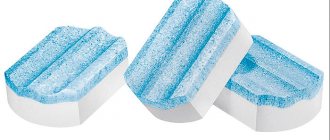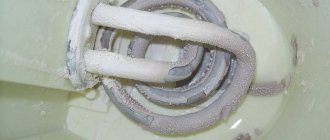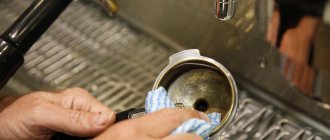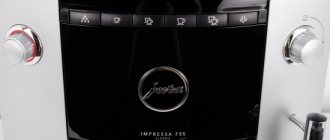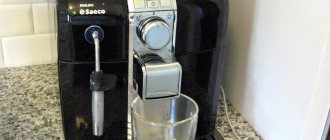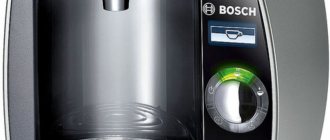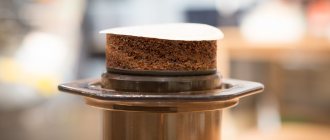During automatic coffee preparation, the machine comes into contact with water and crumbly, oil-based products. Constant heating of water and dissolution of coffee particles leads to contamination of the device, the formation of scale, plaque and oil traces. Lack of long-term care has a negative impact on technology. At best, your drink will lose its original taste; at worst, the coffee machine will simply break down.
Descaling products for coffee machines
To remind the owner of the need for care, some machine manufacturers install a counter for prepared cups of coffee on the display. As soon as the indicator goes beyond a certain limit of 230 cups, the device needs to be serviced. The minimum frequency of maintenance is 2 times a year, provided that soft water is used. The main enemy of a coffee machine is scale. To get rid of it in time, you can use several effective methods.
What is decalcification of a coffee machine
Hard water contains large amounts of calcium salts. They form a loose film on the walls of the coffee machine, which attaches to itself the salts of other metals contained in the water. Decalcification is the process of removing salt deposits.
Mechanical descaling using cleaning pastes containing abrasive particles causes serious damage to the elements of the coffee machine and can lead to serious damage. Therefore, to decalcify and clean coffee machines from coffee oils, special compositions are used that contain substances that soften and remove the scale layer.
Coffee beans contain vegetable oil, which turns into liquid form when heated .
After cooling, drops of oil become thicker and accumulate on the internal elements of the coffee machine. Over time, like any other oil, it becomes rancid, giving the coffee an unpleasant taste.
How scale appears
Any drinking water, even bottled or filtered, contains a certain amount of dissolved salts, mainly calcium, magnesium, and iron compounds.
When water is heated to a boil, some of the salts precipitate , which accumulates on the walls of the coffee machine, forming scale, which leads to wear of parts and breakdown of the device. Over time, this layer becomes thicker and denser. The rate of formation of the limescale layer depends on the concentration of salt in the water.
The harder the water, the more often you will have to clean the coffee machine to remove scale.
How to descale a coffee machine with citric acid
Manufacturers offer a variety of descalers, but they are all quite expensive, and limescale must be removed every month. Large companies such as DeLonghi, Philips, Bosh produce branded cleaning products for their household appliances. You can find universal cleaners on sale, both liquid and tablets.
You cannot use descaling compounds designed to remove deposits from the surface of gas stoves or sinks; this will lead to damage to the machine. The main active ingredient in most branded products is citric acid. Many coffee machine owners have been cleaning their equipment themselves for years using a citric acid solution without causing harm to their equipment.
Citric acid has a number of undoubted advantages:
- safety for human health and the environment;
- efficiency, it removes even old scale;
- no toxic fumes when heated;
- accessibility, it is in any home;
- low price.
All this explains the popularity of citric acid as a cleaning agent for household appliances.
The main cleaning steps are the same as when using a store-bought product:
- filling the reservoir with cleaning solution;
- cleaning process;
- removal of cleaning solution;
- thorough washing.
Let's take a closer look at how to clean a coffee machine using home remedies; the instructions for servicing household appliances will help us with this.
Descaling
The main stages of descaling are the same for different types of coffee machines. It is necessary to strictly adhere to the instructions, only instead of using a special product, use citric acid, having previously diluted it in water.
If you haven’t cleaned your coffee machine for a long time and a solid layer of scale has formed, dissolve 50-100 g of citric acid in one liter of water. If you care for your household appliance regularly, a 30% solution is sufficient (proportions: 30 g of acid per 1 liter of water).
Sequencing:
- Prepare a solution, stir until the acid is completely dissolved.
- Fill the reservoir up to the mark indicating the maximum amount of liquid possible.
- Insert the container with the solution into the coffee machine and carry out the cleaning procedure, following the instructions. If your equipment does not have an automatic cleaning function, pour in the solution, wait a quarter of an hour, turn on the device by selecting the “coffee preparation” function.
- Turn off, remove the reservoir, pour out the remaining solution, rinse.
Almost all modern models have a scale formation indicator ; if you do not have such a function, descale the coffee machine with citric acid every 1-2 months, depending on the frequency of use of the household appliance and the hardness of the water.
First rinse cycle
To prevent residual citric acid from spoiling the taste of coffee, the coffee machine must be rinsed thoroughly:
Fill the tank with clean water to the maximum level, install it in the machine, select the “coffee preparation” function without adding coffee powder. The first rinse will take you 3-5 minutes.
Second rinse cycle
To completely get rid of citric acid, rinse the tank thoroughly, fill it with clean water, and repeat the “coffee preparation” mode without adding coffee itself. This completes the procedure for cleaning the coffee machine with citric acid, and the scale has been removed.
Process
Mix water and vinegar. Pour the solution into the fluid reservoir. Set the machine to cleaning mode or cooking mode. Repeat all steps, filling the reservoir with clean water.
Undoubtedly, cleaning a car with folk remedies is cheaper, but they also cost a lot. In addition, according to professionals, traditional methods do not work as well as a specially developed means for decalcifying a coffee machine. Therefore, if your car has not been cleaned for a long time, start caring for it immediately with a professional deposit cleaner.
How to descale a coffee maker with vinegar
Vinegar is a natural cleaning agent that removes limescale and grease residue well; it is often used to descale coffee machines at home, along with citric acid.
Cleaning method:
- Prepare a cleaning solution: add 2 parts water to 1 part vinegar.
- Pour the solution into the water container, insert it into the coffee machine, and turn on the cleaning mode. If there is no such mode, select the “coffee preparation” function.
- After turning off the household appliance, wait 15–20 minutes for the scale to dissolve better
- Rinse the tank, fill with clean water, and bring to a boil as you would brew coffee. Drain the water and repeat the procedure.
When heating, vinegar vapors are very unpleasant for humans; open a window for ventilation.
Cleaning with decalcifiers
All manufacturers of household appliances recommend using descaling products offered by the same company to descale your coffee machine. This is indicated in any instructions. However, all products are created using the same technology and have a similar composition. They are available in both liquid and tablet form:
- Not everyone can afford to clean a coffee machine using DeLonghi Branded products are of high quality and guarantee excellent results.
- Cleaning a coffee machine with Saeco descaling agent is cheaper, but it is almost as good in terms of quality.
- Other companies offer their own cleaning products to care for household appliances.
DeLonghi
Saeco
Special cleaners for Delonghi devices
To remove scale from Delonghi coffee machines, it is recommended to use branded cleaners. They can be purchased online:
Delonghi “Eco Calc” descaler for automatic coffee machines. The product contains natural ingredients that allow you to carefully clean the device from scale. One bottle is enough for 5 cleanings. The cost of 500 ml of solution is 1270 rubles.- Delonghi DLSC500. This is a universal composition that can be used to clean not only coffee machines, but also coffee makers. The price of one bottle is 1430 rubles.
- Delonghi DLS200. The composition is designed specifically for cleaning coffee machines to remove scale. It is bottled in small plastic containers of 100 ml. One sachet is enough for 1 cleaning cycle. There are 2 containers in the package, the price is 750 rubles.
The manufacturer warns that the use of other descaling agents may negatively affect the functionality of the device.
The video will show you how to remove scale from a Delonghi coffee machine using a proprietary cleaner:
What happens if the coffee machine is not cleaned?
Any water other than distilled water contains minerals and chemical elements. The main one is calcium. When water is heated, calcium salts precipitate, forming limescale.
The surface of the scale is porous; salts of other metals settle on it, and over time, microorganisms can multiply in these pores. All this negatively affects the technical condition of the household appliance and the taste of coffee.
The main signs of scale appearance:
- change in the smell of the drink, it becomes unpleasant;
- getting cereal into a cup;
- the feeling that the coffee has not been brewed enough, its strength has become less;
- reduction of steam pressure;
- weakening of the drink stream, this applies to a lesser extent to coffee machines with a boiler as a heating element; the likelihood of blockages is lower than for models equipped with a thermoblock;
- changing the sound of the coffee machine during operation.
Some modern appliances are equipped with sensors for automatically checking the scale level; a notification appears on the panel that the coffee machine needs to be decalcified. This warning must not be ignored. Even if automatic blocking does not occur, the device may soon fail.
When does a coffee machine need cleaning?
The frequency of cleaning the device depends on the frequency of its use, design features and the water you pour into the liquid container. Avid coffee drinkers are advised to thoroughly clean the working parts of the device and carry out preventative maintenance at least once every 2 months. If you use regular tap water, cleaning should be done more frequently and monthly.
Coffee machine tablets
The presence of scale on heating elements appears as a fine white sediment at the bottom of a cup of coffee. You may notice that the machine becomes louder and the flow of liquid from the drink outlet becomes thinner. In addition, there may be an increase in energy consumption and coffee preparation time.
On some Delonghi, Philips, Nespresso and Saeco brand machines, the cleaning indicator on the instrument panel may light up. All these signs indicate that your household appliances need care. Delaying maintenance may result in device failure.
Useful tips
Proper operation and proper care of the coffee machine is a guarantee of long-term operation. Clean your appliance's major systems regularly and you'll be enjoying fresh coffee for years to come.
Basic rules of care:
- Make sure that the equipment is always dry and immediately remove moisture with a napkin.
- Change the filter promptly.
- Wipe off spilled coffee from the auto-heating stove; it will retain heat longer.
- Clean the container of any remaining coffee grounds and milk so that the sour smell does not spoil the taste of the coffee.
- Descale in a timely manner.
Professional or folk remedies will remove residual milk, coffee fats, and limescale. It is important to do this regularly, following the instructions.
To make caring for your coffee machine easier, prevention is necessary. Use clean, soft water, bottled or filtered, to make coffee. Water that has undergone double purification (the first - using a household device, and the second - directly in the coffee machine) causes the formation of limescale to a lesser extent, and decalcification is required much less frequently. If you follow all these rules, breakdown of coffee equipment is practically impossible.
Saeco
Only proper care of your coffee machine will extend its service life. When everything inside is overgrown with scale, this smart technique displays the inscription “Descall” on the control panel.
The indicator also lights up. This indicates that it is time to clean the device.
One of the best products for removing plaque from Saeco is KAVA Descoling Agent and Saeco Liquid.
The first composition is cheap, it is enough for six uses. The second substance is expensive and is only enough for 2 cleanings.
How to clean the inside of a coffee maker from limescale deposits:
- 250 ml of liquid is poured into the reservoir, the rest is added with water.
- Then you should start the decalcification program and wait for it to complete.
- After which the device requires thorough flushing of the entire system.
It is important to clean equipment regularly. If you do not care for it correctly, this will lead to a decrease in the amount of drink dispensed, an unpleasant aroma of coffee, noisier operation of the device and the formation of unsightly foam.


